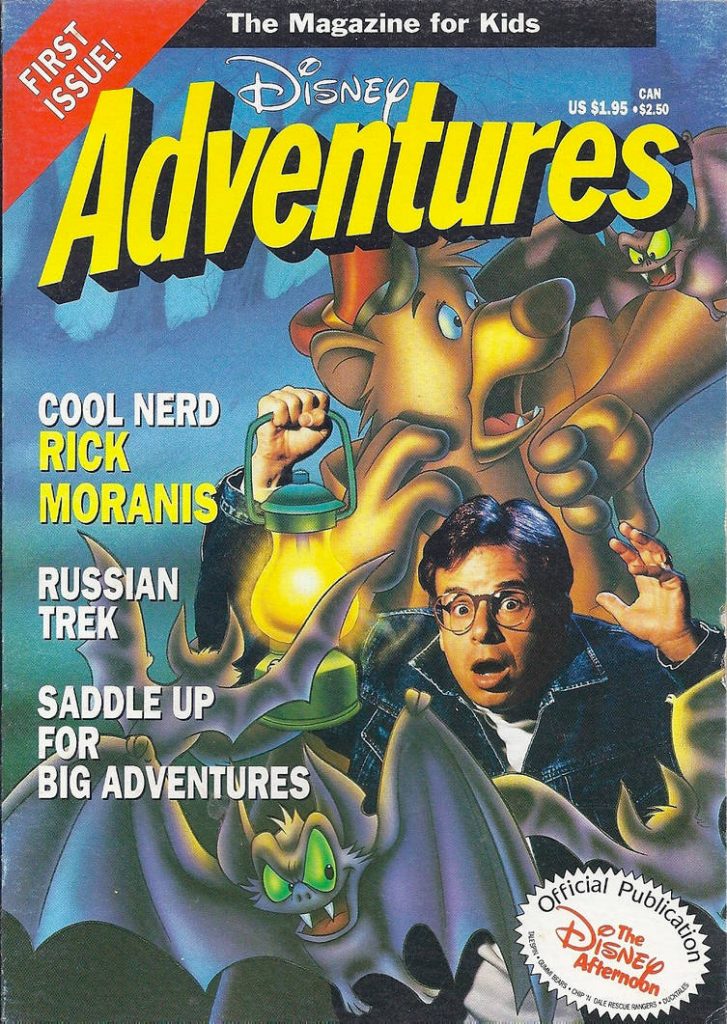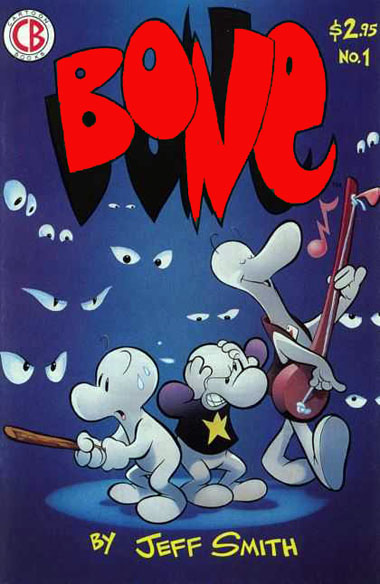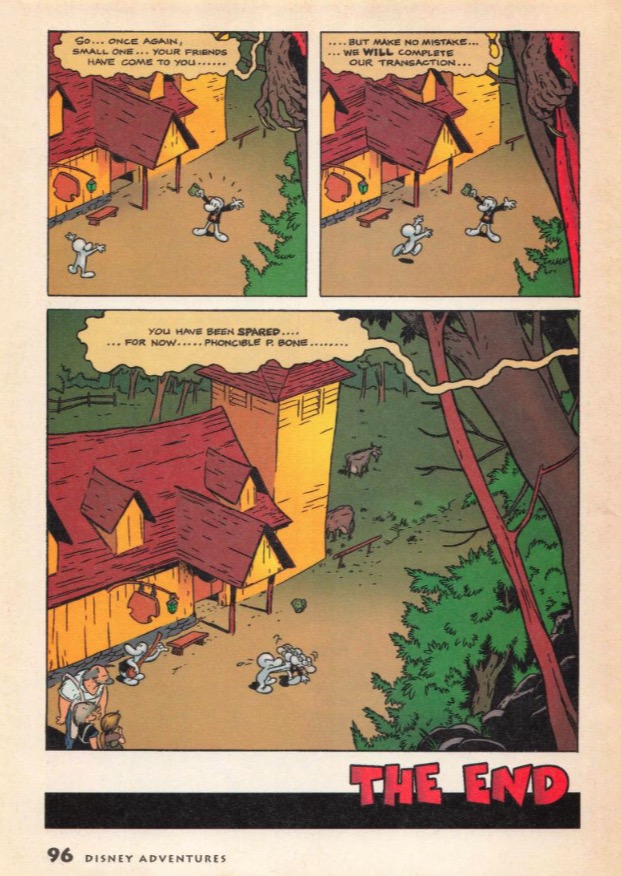“It Kind of Changed My Life”: The Story of Bone’s Time in Disney Adventures, From the People Who Made It Happen
While it might be difficult to imagine in 2025, a magazine was one of the biggest deals for kids back in the 1990s. Disney Adventures, a monthly, digest-sized publication, was loaded with everything those readers wanted. Features on the biggest names for kids, from Jim Carrey and “Weird Al” Yankovic to Ken Griffey Jr. and Michael Jordan. 1 Puzzles and activities galore. Articles about the coolest movies and shows, from The Fresh Prince of Bel-Air and Wayne’s World to Disney faves like The Lion King and DuckTales. It truly had it all.
And yes, that included comics.
Disney Adventures debuted in 1990, just six years after I debuted in 1984, which meant I was in the sweet spot of its fanbase. It was an essential part of my youth, as my family had a subscription and I read it religiously. It also quickly became the type of conversational currency that connected me with other kids, giving me a skeleton key offering for anyone of roughly the same age. A new friend was just the latest issue away. Oh, and I loved it. But I wasn’t unique in that regard. Seemingly everyone was into Disney Adventures then. Variations of my story were not uncommon during that period.
That isn’t just me saying that, either. Disney Adventures at its peak had a circulation of over a million a month, and that doesn’t even include all the kids who read it because friends or family shared it with them. 2 We all wanted to bask in the glory of DA, as it was affectionately known. 3 In a decade loaded with shared experiences, this publication was one of the biggest for kids, if only for a time.
When I started reading Disney Adventures, I was already into Jeff Smith’s Bone, his Cartoon Books comic series about a trio of largely featureless and almost cartoon character like beings lost in a land quite unlike their own. Somehow, my family had ended up with its first issue 4 and quickly realized it was special, so we began to buy each subsequent one. That was not a shared experience, though. While we know Smith and Bone as comic superstars today, this was before it had hit it big. And at that point, reading comics like Bone was a private activity for yours truly.
Or it was until Bone debuted in DA in its April 1994 issue, a moment that changed my life as a fan and the lives of many involved with it. The comic series only appeared in 18 issues of Disney Adventures, 5 but Bone being published in its hallowed pages legitimized its greatness while allowing me to share it with others in a way that was practically impossible with other comics at the time. More importantly, it helped send the series into the stratosphere, connecting it with an audience it may not have met otherwise.
Disney Adventures has always quietly been an essential part of Bone’s journey. We know that. But how did it end up in the magazine? Who made it happen? And what was its journey like? Those are questions I’ve always had about a magazine I loved and the wonderful comic that appeared in its pages. So today, I found answer, as we’ll be exploring Bone’s time in Disney Adventures with insight from the people who made it happen.
The story of Disney Adventures begins with the founder of Disney Publishing, Michael Lynton. He grew up in varying places, having been born in the United Kingdom and raised in the Netherlands, a background that inspired his love of cartoonist André Franquin and his creations like Marsupilami. He was a comic fan at heart, having been raised on the Mickey Mouse digest Topolino from Italy, a publication that was equally comprised of comics and text. According to Heidi MacDonald, it was the root of Disney Adventures as an idea.
“’Let’s do (a magazine like Topolino) in the United States,’” MacDonald said about Lynton’s pitch to Disney. “And he sold Disney on the idea.”
There were many players involved with Disney Adventures, but the comics side began with a familiar face from the medium. Writer and editor Marv Wolfman was hired as its first Comics Editor about a year before the first issue arrived in 1990. His mandate was to create the comic side of the magazine with an objective that was clear from the start.
“The job that was to do comics on The Disney Afternoon 6 characters,” Wolfman said. “I could do other stuff as well, but about 90% of the time, it had to be stories about The Disney Afternoon (characters).”
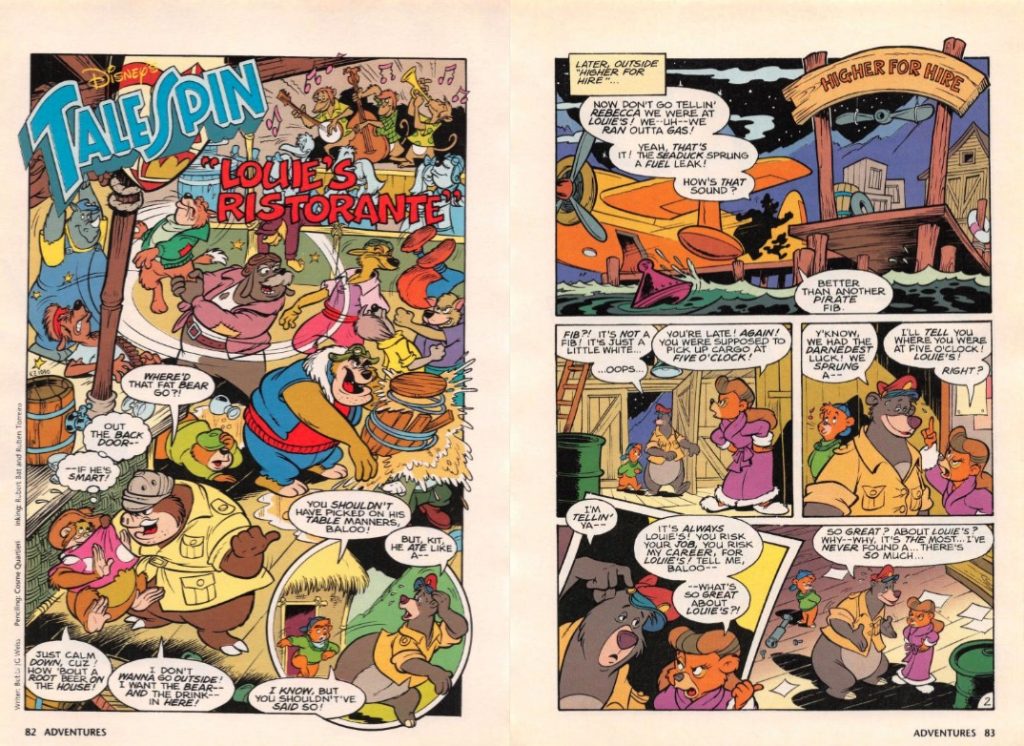
The job itself was not unlike a typical editorial job in comics. They had to find artists and writers to bring these stories to life, because, as Wolfman said, “we had so much work” that had to be done “very quickly.” While he knew what he had to do from a magazine standpoint, Wolfman had his own goals for the comics they created at Disney Adventures. It was “important” to him that “different age groups could enjoy different parts of the book so that we could keep people involved with the book forever.”
“And it worked,” he added.
“We had really interesting stuff and a huge readership.”
He wasn’t building for that audience of a million plus alone, though. MacDonald — the Eisner Award-winning comics journalist from The Beat — worked at Disney Adventures from 1991 to 1999, where she started as its Associate Comics Editor. She worked with Wolfman to keep the comic side of the magazine rolling, which was important because it proved to be an essential part of the experience for many readers.
They were doing it at an odd point in comics, though. While the comic industry was booming thanks to monster hits like Spider-Man #1, X-Men #1, and other debuts and landmark issues that arrived in the early 1990s, “comic shops weren’t really set up” for a younger audience according to Wolfman.
“There were superheroes at that particular point and that was about it,” he said.
That was the environment in which Wolfman “discovered” Bone, as MacDonald put it. Jeff Smith’s self-published comic series debuted in July 1991, and what guided him to it was a mention the title earned in an issue of Comics Buyer’s Guide. 7 Wolfman had never heard of it. All he knew was that it was supposed to be a quality work that was aimed at all-ages, which was exactly what he was going for in Disney Adventures. He had to know more, so he went to the comic shop to try and find it.
“I bought the first three and fell in love with it immediately,” Wolfman said.
Lynton and MacDonald did as well when Wolfman shared it with them. It also fit the vision everyone had for Disney Adventures, so the next step was clear. They wanted to talk to Smith to see if they could publish Bone in Disney Adventures as well. This was the early 1990s, of course, so it wasn’t as easy as Googling someone to find an email address. Wolfman had to go through backchannels. So, he turned to Maggie Thompson, the person who ran Comics Buyer’s Guide, who then found a phone number for Smith.
“I called Jeff,” Wolfman said. “And he was shocked anyone had read it.”
At that time, “Bone sales were not very good,” as Wolfman put it. Smith was even more specific about where things were when this pitch was first made.
“The first issue sold like 1,500 copies, which is a small amount, but enough to pay for the printing and have a little extra,” Smith said. “But issues two through four continued to drop. Actually, Bone #4 did not sell enough to pay for the printing.”
That’s part of the reason Smith was intrigued by the interest Disney Adventures had in his comic. It was a good way to gain visibility for it in a hurry. But it was more than that. When Smith was a child in the late 1960s, he read “another little digest you could get at the grocery store called Walt Disney’s Comics Digest.” That Disney magazine was how he discovered cartoonist Carl Barks, which was huge for him.
“I’d never seen artwork like that. Carl Barks became my hero when I was nine years old because he was drawing these cartoon characters like Donald Duck, but he was making them take scientific equipment down to the bottom of the deepest part of the ocean to go to Atlantis,” Smith said. “I remember the shot of the ducks floating down and way below them he drew Atlantis, but it was lit up to like a city at night. It was fantastic.
“That was the beginning of me wanting to draw comics.”
It was a full circle moment for Smith. It only felt right that his own comic ended up in a Disney magazine given that his comic roots were found in one long before.
Of course, it all depended on the deal. The biggest thing was Smith had to own the rights to Bone. When Wolfman checked in with Disney, they were open to that, which might sound bewildering today but was on the table then. It probably helped that the publication’s comics team was behind him from the start, which Smith fondly recalled.
What exactly the deal entailed is where things get murky. When you do these types of history pieces, especially ones that go back decades, sometimes people remember things differently. Smith believes that Disney’s ask was for an original eight-page story featuring the cast of Bone. MacDonald said Wolfman initiated the deal, but that the agreement was for that original comic and splitting the first issue into three different chapters in Disney Adventures. Whatever the deal was, it resulted in Bone being published in Disney Adventures, something Wolfman was thrilled about.
“I was so happy to be able to help Jeff get an audience at Disney,” Wolfman said. “It was wonderful because that book deserved to be seen by everybody.”
Bone’s original stretch in Disney Adventures took place in 1994, with the first issue published in three chapters between April and June 1994 before that original comic Smith mentioned arrived in August of the same year. But it’s worth noting that the environment it debuted in was much different for the comic and its creator. Between Wolfman’s first outreach and its initial publication, Bone began to earn acclaim from notable creators and from outlets like The Comics Journal.
Buzz started to form, especially around the idea of The Great Cow Race, an event Smith never actually planned on drawing. He just loved the theoretical idea of the character Gran’ma Ben racing cows. As the conversation around it grew, Smith said sales for the series went from around 1,000 an issue to 60,000 in just five releases, with readers constantly writing in about how excited they were to see this race take place.
“I was like, ‘I gotta make up a cow race,’” Smith shared. “I did, and fortunately for me, it worked out.”
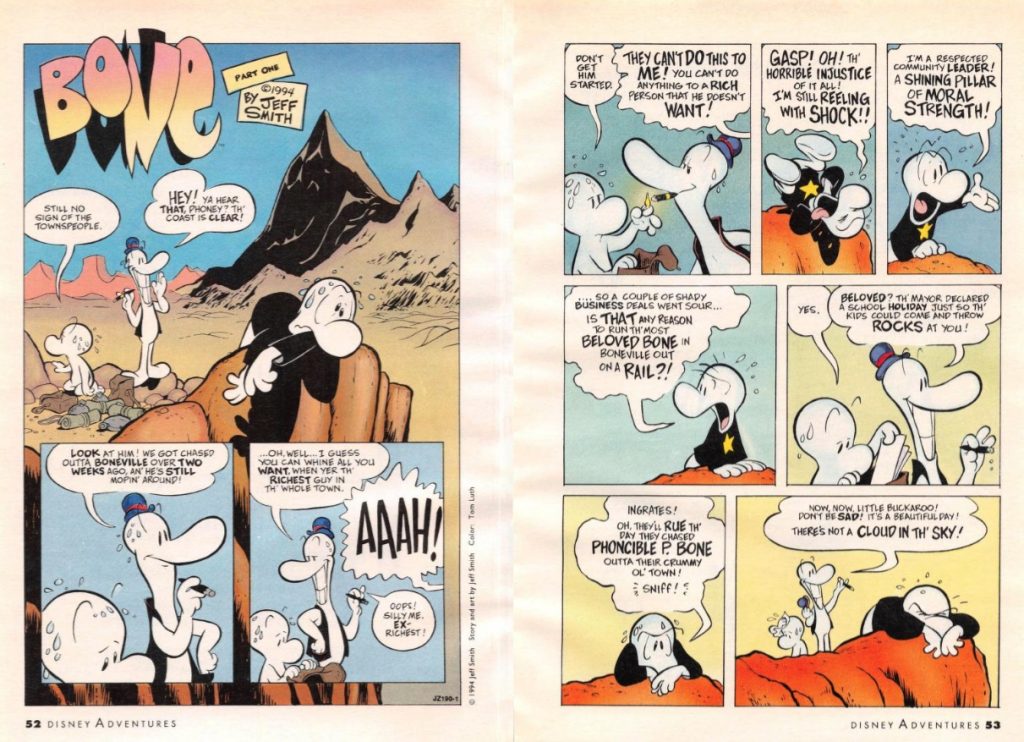
That’s roughly where Bone as it headed towards its debut in Disney Adventures. The comic series has grown in audience. Now the team just had to bring it to life in the pages of DA starting with its first chapter, which hit in the April 1994 edition of Disney Adventures. Smith split the first issue into three parts and Wolfman and MacDonald executed the idea from there. Both editions weren’t exactly the same, though.
There was at least one major difference between the version that appeared in comic form and the one that was in Disney Adventures. As Smith said, “(Disney) wanted to color it,” which he was okay with, even thought it was his “intent for Bone to be black and white.” And MacDonald knew the right person for the job.
“I was hot for Tom Luth to do it,” she said.
Most prominently known for his coloring work on Stan Sakai’s Usagi Yojimbo, Luth was brought in as the first person who ever colored Bone. Smith was happy with that, as he knew Luth was a capable colorist. And he wouldn’t just be coloring that first issue, but that eight-page story that first appeared in Disney Adventures in August 1994.
Titled “May the Force Be with You,” this Bone story that first appeared in DA was a charming jaunt from Smith and Luth that the cartoonist “thought was fun.” It was jarring to revisit if only because of where it’s sequenced in Disney Adventures, 9 but the end result is an entertaining read. Its name didn’t stick, though. When Smith reprinted it later in the first Tall Tales compilation of Bone, he dubbed it “The Powers That Be.”
“Just because I didn’t want to steal from (George) Lucas,” Smith admitted.
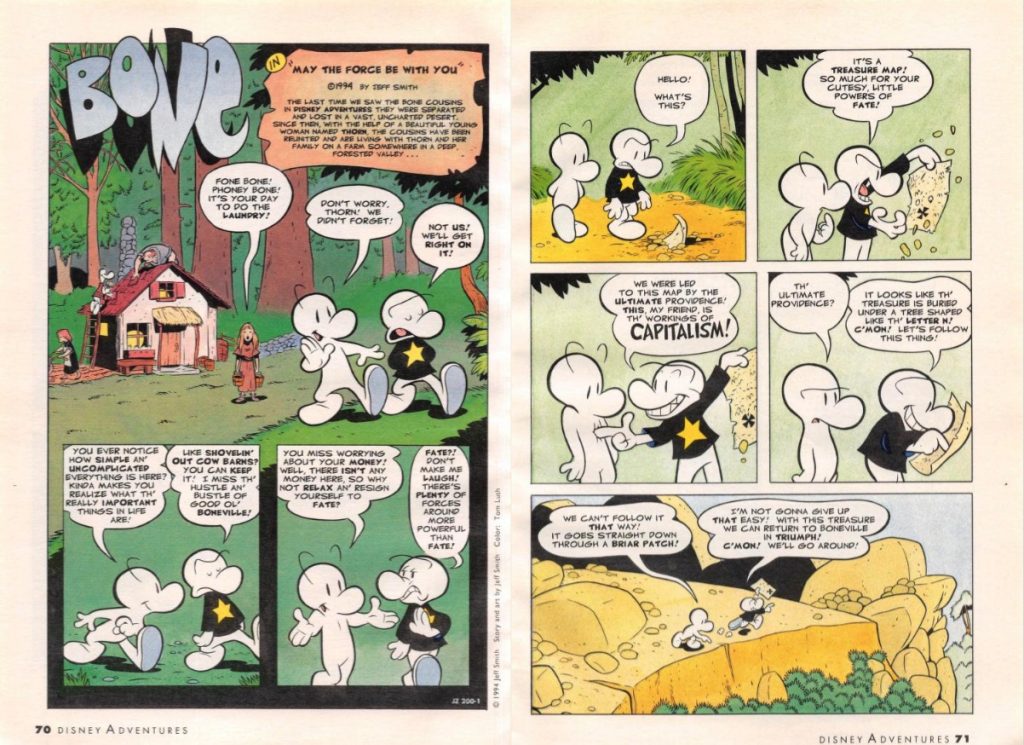
The response to that opening salvo of Bone in Disney Adventures is another divergent point amongst those I talked to. Wolfman said readers “loved it” and Disney did as well. Smith, on the other hand, remembered that the response “wasn’t immediate,” even if he quickly realized something it did bring to the table.
“(Bone) was suddenly the most-read comic in the comic book business overnight because (Disney Adventures’) readership was over a million,” Smith said. “And each one is supposedly read by brothers and friends, so I was shot right up to the top of the most read comic books.
“And that was exciting.”
Bone was the most read comic book.
And then it was gone from the magazine altogether.
“May the Force be With You” was the last time readers saw Bone in Disney Adventures for nearly three years. Its departure wasn’t because of poor performance or Disney not liking the comic or anything like that. It was something far more practical.
“We got caught up in moving from California to New York,” MacDonald said.
Disney Adventures was based in Burbank when Bone arrived in its pages, but the outfit moved to New York City in the midst of its run. That brought an end to its time in DA for then. It also concluded Wolfman’s run at the publication. While he “loved working at Disney,” he had just relocated to California to work at the magazine and had grown fond of his new home. So, he stayed behind, with MacDonald taking over as the new Senior Editor, Comics. 10
It was a strange period for Disney Adventures and its comics section. The 1990s were a high time for magazines. MacDonald described it as like “tech is now,” with everyone in the space being “glamorous” and “influential.” The magazine side of DA was “snobby and looked down on comics” for a time, even keeping the two departments in separate offices while ensuring that the comic people were freelancers rather than full employees. Comics were the “stepchild” of the whole affair, with MacDonald saying they were “hated and looked down on.”
That changed once the magazine moved to New York and a new Editor-in-Chief stepped in. It was Phyllis Ehrlich, whose husband Joel Ehrlich worked for Marvel Comics at the time. That ensured she was “very comics friendly,” according to MacDonald. And the two got along famously, which meant that DA’s comics head had the runway she needed to do the right thing for the magazine. Like, say, bringing back Bone.
At this point, MacDonald was friendly with Smith and his wife Vijaya. They were part of the same crowd at cons, which “kept (Bone) top of mind” for MacDonald.
“So, when Phyllis was like, ‘We should do some original comics,’ I was like, ‘Oh, why don’t we reprint Bone?’” MacDonald said. “It seemed to go pretty well the first time we did it.”
Before we move on to Bone’s return, though, we must introduce the final player in this story. Like in the early days of Disney Adventures, its comics lead needed a teammate. During Bone’s second run in DA, it was a familiar name in his first paying job in the comics industry.
“I was looking for work in comics right after Marvelcution, 11 and I was just like, ‘Wow, I’m never going to find any work in comics,’” Cliff Chiang told me. “But (then Marvel editor) Joey Cavalieri put me on to Heidi because her assistant was leaving.”
That’s how the renowned artist first entered the industry as the Assistant Comics Editor of Disney Adventures. His job there wasn’t dissimilar from a later editorial role he had at Vertigo Comics, 12 as he worked closely with MacDonald to manage the day-to-day of the ongoing machine that was Disney Adventures’ comics side. Getting creators what they needed, putting reference material and color guides together, double-checking anything and everything…you name it, Chiang did it.
And now, he’d be doing it on Bone.
Bone returned to Disney Adventures in April 1997, three years after its initial debut. It was a journey in getting there, as both MacDonald and Smith recall, but not just because of the magazine’s big move.
“This time I was intimately involved in the negotiations, and I remember it took a long time to hammer out this contract,” MacDonald said. “There was a lot more meat to it this time.”
“I had lines I couldn’t cross, and they managed to figure out ways to get around some things,” Smith said, before adding, “So, we did it.”
What Bone’s return was proved to be pretty simple. As MacDonald said, “we signed up for continuing the run.” It picked up from the conclusion of the first issue way back in June 1994, with material from the second issue debuting in DA’s April 1997 issue. The plan was to deliver the first arc of Bone in Disney Adventures — or the material collected in the “Out from Boneville” volume — with Smith continuing to divide the issues up into satisfying chunks.
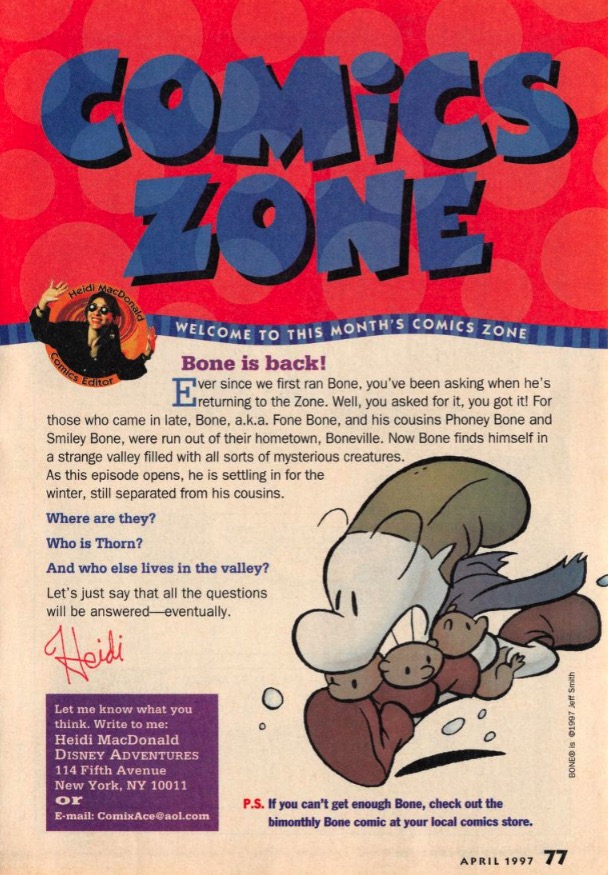
By that point, there had been enough reader support for Bone that its return issue saw the comic section open with a letter penned by MacDonald about how Bone was back by popular demand. While it was successful in its first stint, apparently the thirst for more only grew in its absence.
It was quite the early job for Chiang, who was rather fond of Smith’s work. Now he was at least in part responsible for letting the Bone team know the changes Disney asked for and working with them to see what could be done to make those happen.
“I was a young assistant editor, just very nervous about calling,” Chiang said. “But (Jeff and Vijaya) were always super professional about everything whenever we needed it.”
One of the biggest changes in this second run was the addition of recap pages that introduced each chapter. The belief is that this was a Disney ask, but Smith supported it. He had always preferred to ensure that new readers know what’s going on in his work.
“I had done Bone as a four-panel comic strip in college for years, and every day, the first panel had to remind the readers where they were,” Smith said. “So, I was attuned to that idea that if you’re in the middle of a story, you have to spend a little real estate on catching people up.”
That was easy, both in terms of agreement and execution. What was slightly more difficult was the need to change parts of the comic itself. As Chiang said, “anything that wasn’t all ages” needed to be altered. While he admits it’s “funny to think of Bone being objectionable at all,” the comic wasn’t intended for a Disney audience. While most of it was fine, some changes were necessary, with there being two main problems. According to MacDonald, one was the smoking and drinking in the comic. For example, when The Great Red Dragon arrives, he’s smoking a cigarette.
“We took the cigarette out of the Dragon’s mouth,” MacDonald said. 13
Other parts were more complicated. Fone Bone, the lead of the comic, meets its heroine Thorn in the second issue. When he does, there’s a smidge more nudity than Disney preferred, in the sense that there was any perceived nudity at all. 14 Per MacDonald, Smith didn’t want to redraw the scene, so they had to find a different solution.
“So, I just said, ‘Well, just pull out that panel,’” she shared. “If you look at it in the comic, it was a six-panel grid, and then there’s this one page where there are these two blank panels, and we just blew it up.
“It was the most primitive fix ever, but that was it.” 15 16
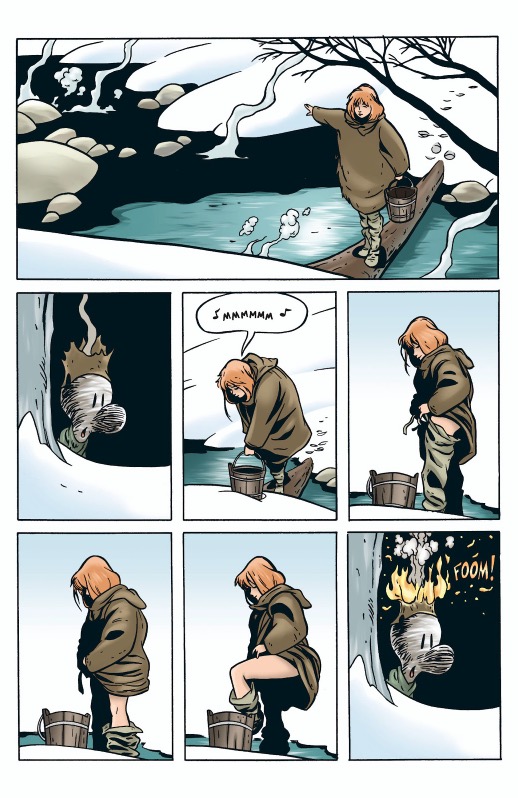
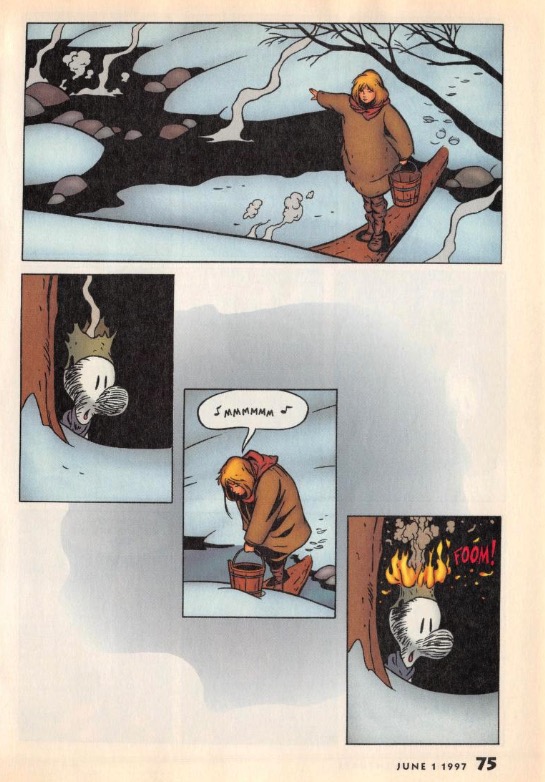
Chiang theorized that Smith had to “on some level bristle at editorial changes,” if only because the “ethos of self-publishing is to not have to deal with any of that crap.” He wasn’t wrong. Smith said, “I wasn’t crazy about it,” even if he admitted that he did “get it.”
Whatever the journey to the end result was, Bone was finally back by popular demand. But it turns out that was just the tip of the iceberg in terms of how it was perceived by readers. You see, Disney Adventures had reader surveys, “and because it’s little kids, they love filling these things out and sending them in,” per Chiang. 17 That’s how they learned what readers really thought of Smith’s creation.
“The best part was when we started running Bone regularly and it became the most popular comic in Disney Adventures,” MacDonald said.
The team knew that despite the mixed feelings leadership had about the comics section at times, it was consistently the second most popular section of Disney Adventures behind its puzzles in those surveys. What they didn’t know was which strip fueled the affinity readers had for it.
“We did this survey, which was, ‘Which comics do you like the most?’ We were probably running Timon & Pumbaa by then as well as Goof Troop and Bonkers,” MacDonald said. “We had a checkbox for ‘What’s your favorite comic?’
“And Bone won.”
That was a massive change from its early days. MacDonald described Bone’s first run as an “experiment,” one that connected but was limited by the length of its run. But when its second effort hit under its new “pro-comics regime,” “(Bone) was insanely popular to the point we got letters about it all the time.”
This was a big deal on several levels. Per MacDonald, Bone being “one of the most popular parts of the magazine” legitimized the comic side and the decisions its team was making. But it also shifted everything in a direction of original comics being necessary, with the added question of, “Should we do this without owning it?” entering the picture. That was a major change.
That wasn’t why Bone ended its time in Disney Adventures for good just a little over a year into its second run. It concluded with the May 1998 issue, with the final vision readers getting of its cast being Fone Bone choking out his endlessly frustrating cousin Phoney Bone upon their arrival at the Barrelhaven Tavern as the Hooded One monologued menacingly nearby. MacDonald was “heartbroken” by its conclusion. She loved publishing Bone in Disney Adventures. At this point, though, Smith viewed it as a good stopping point for that partnership, and for purely story reasons.
“It was the end of the first graphic novel of Bone, and I thought that was a good, complete arc. The first issue, they get separated. And the last issue of that arc, they’re reunited,” Smith said. “So, that was just a good time to end it.”
And like that, Bone’s journey with Disney Adventures was complete.
Regardless of when it ended, it’s something everyone looks back on fondly. They all raved about the collaboration, with Smith describing it as “a good experience.” More than that, he adored working with Wolfman, someone Smith “was a big fan of” already, and it resulted in him becoming friends with MacDonald — a friendship that continues to this day.
Bone’s time in Disney Adventures made a real difference in the long arc of comics in ways both predictable and surprising. One was how it pushed the publication to lean further into original comics, both after its initial run in 1994 and its second in 1997 and 1998. Notable names like Arthur Adams and Evan Dorkin told new tales within its pages, and it’s entirely possible that wouldn’t have happened without Bone.
Another person it affected was Chiang, whose comic journey began here. He wanted to be an artist, and he was already a huge fan of Smith and Bone when he started at DA.
“Bone was important to me in learning the visual grammar of comics because Jeff’s storytelling is so crystal clear and exciting and easy you could give Bone to anybody and they’d be able to follow it, which you can do with comics that are very simple,” he said. “But Bone is layered and visually complex, and there are things that are happening that are almost subconsciously.”
The editor-turned-artist added, “it was a big deal for me to see these pages coming in large and seeing what he changed for publication,” as well as building a connection with the team at Cartoon Books. In fact, that budding relationship led Chiang to the moment he realized he was in comics for real, one he speaks of fondly all these years later.

“The funny thing is, I didn’t get to talk to Jeff a ton (at DA), but he attended SPX 18 either in 1997 or 1998,” Chiang said. “I remember seeing him across the bar and we just kind of raised a glass to each other and he nodded to me. That was just a great moment for me. I was like, ‘Wow, I’m in the industry now.’
“’I’ve made it.’”
It changed the lives of readers as well. For many, Bone appearing in Disney Adventures shifted how they viewed comics and what the medium could be. As MacDonald put it, “You get (Disney Adventures) and it’s normal. Here’s the new Disney movie. Here’s Jonathan Taylor Thomas. And then there’s this weird, magical thing (in Bone) that you’re like, ‘Oh, this is so cool.’” It was a moment for a certain generation of reader and the medium itself.
“(It was) a massive fork in the road in comics because Bone became a sensation,” Wolfman said.
“Even to this day, I never go to a show and there aren’t a handful or more of people that come up and say (Disney Adventures was) where they read it first,” Smith added.
Of everyone and everything it affected, though, Bone’s time in Disney Adventures certainly impacted its creator and his creation the most. That’s something Smith recognizes, and it’s why he’s still so “grateful” for Wolfman and MacDonald’s efforts in bringing it to the magazine. Smith and Bone were always destined to be a success, but MacDonald’s belief is Disney Adventures “gave him a faster car.” He appreciated that.
Its appearances in Disney Adventures didn’t affect the content of the comic itself. Smith always knew what it was and was steadfast in that creative belief. In his mind, “the great benefit was the audience” and “the range of people that saw it” because of Disney Adventures. It went from a comic that couldn’t even pay for its own printing costs to a big hit in comic shops to the most popular comic in what was almost certainly the most read magazine in America for young people. 19
How can you quantify that kind of impact? You can’t. It’s more a feeling, and a sense that nothing was ever the same for the comic or its creator from that point on.
“(Bone is) this weird little book when you look at it. It’s got monsters and little Smurf characters. But when it was in Disney, it was like, ‘Well, Disney knows what they’re doing,’” Smith said. “It really took off, and I do think that Disney Adventures had a lot to do with that.
“It kind of changed my life.”
Thanks for reading this feature on Bone’s time in Disney Adventures. If you enjoyed this article and want to read more like it while supporting the work that goes into it, maybe consider subscribing to SKTCHD. This is an independent site with no ads that’s run by one person, and it’s entirely powered by subscribers. A subscription is the price of about one comic a month, and it comes with a seven-day free trial if you’d like to check it out.
As well as multiple cover stories on Rick Moranis and one on Bronson Pinchot of all people in its first three years.↩
Per Heidi MacDonald, someone who worked at the magazine for a time, its estimated readership — not circulation — grew to be as high as six million.↩
Both internally at the magazine and with readers.↩
Not the first printing.↩
Based on my count, at least, with the title’s first six issues being collected across 17 issues and one original Bone story appearing in another.↩
A two-hour programming block of cartoons that were syndicated to local TV stations around the country, which featured shows like DuckTales, Darkwing Duck, Chip ‘n Dale: Rescue Rangers, and TaleSpin, amongst others.↩
A long-running magazine that reported on comics and its industry.↩
All Disney Adventures interiors came from Archive.org.↩
When it arrived, Fone Bone had just arrived in The Valley and both Thorn and Gran’ma Ben — who appear in the open of this one-off tale — had not been introduced yet.↩
She said the reason she didn’t get the same title as Wolfman was because DA’s Editor-in-Chief “didn’t like (Wolfman) because he technically was her equal,” which ensured MacDonald would never get “a title that was as high as what (Wolfman’s) was.” She did eventually earn Wolfman’s title as DA’s Comics Editor, though.↩
A period in 1996 that led to hundreds of employees at Marvel and its associated companies being laid off.↩
Where he also worked with MacDonald.↩
Smiley Bone also lost his cigar, a denizen of the Barrelhaven Tavern lost his pipe, and Phoney Bone drinks a soda in Barrelhaven instead of a beer.↩
It was really just the very bottom of her bottom, so to speak.↩
A similar bathing scene in the fourth issue used a similar solution as well, although it skipped through an entire page of the issue altogether. A brief shot of Thorn’s cleavage is also covered up in the April 1998 issue of DA.↩
One final note on changes. Every issue is split into three chapters in Disney Adventures, besides #6, which is only two. A section from the issue where Phoney and Smiley discuss a scheme to fix the Great Cow Race and the Hooded One shows up to harass Phoney was cut in DA. It wasn’t clear why.↩
Guilty as charged!↩
Small Press Expo.↩
You might be wondering if DA played a part in Bone landing at Scholastic Graphix. Smith said, “I don’t know if the Scholastic deal would’ve happened without DA because it helped bring Bone to a wider audience, but there was a lot of time in between DA and Scholastic (so) I don’t think there was an immediate connection between the two.”↩

